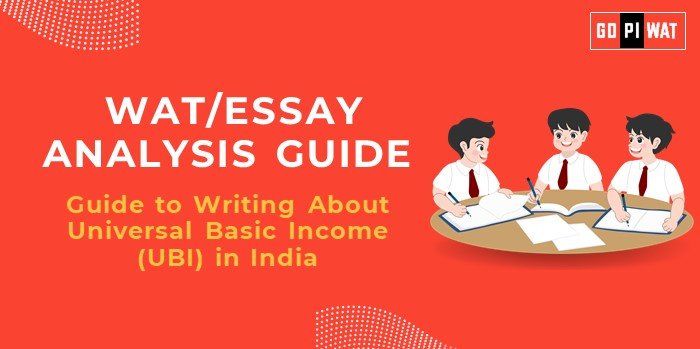📋 Guide to Writing About Universal Basic Income (UBI) in India
🌐 Understanding UBI’s Importance
Universal Basic Income (UBI) represents a transformative approach to welfare, aiming to provide a minimum income floor that addresses income inequality, poverty, and financial insecurity. In India, where over 42% of the population relies on low-productivity agriculture, UBI could not only lift people from poverty but also catalyze a broader economic transition. B-school applicants should understand UBI’s potential impact on economic modernization and its relevance to India’s development goals.
📝 Effective Planning and Writing
- ⏱️ Time Allocation:
- Reading & Planning: 5 minutes
- Writing: 20 minutes
- Review: 5 minutes
- 📚 Preparation Tips: Gather current data on income inequality, welfare spending, and outcomes from UBI pilot studies both in India and abroad. Be prepared to discuss UBI’s economic impact, particularly in shifting the labor force toward more productive sectors.
💡 Introduction Techniques for Essays
- Contrast Introduction: “While India has made significant strides in poverty reduction, 42.3% of its population still relies on low-productivity agriculture, contributing only 18.2% to GDP. In this context, Universal Basic Income (UBI) emerges as a potential tool not just to alleviate poverty but to support economic transition and modernization.”
- Solution-Based Introduction: “Universal Basic Income offers a simpler, more inclusive welfare framework that could both reduce poverty and provide India’s large agricultural workforce the financial cushion needed to transition to more productive sectors.”
📊 Structuring the Essay Body
To effectively analyze UBI in India, consider breaking down your essay into key sections:
🔍 Challenges with Comparative Analysis: UBI’s implementation faces fiscal challenges, with a national rollout estimated to cost 3-5% of GDP. There are also risks of inflation, particularly in rural areas where sudden increases in purchasing power could drive up prices. However, global examples, such as Finland’s UBI trial, provide valuable insights, showing that while UBI reduced financial stress, it had a limited impact on employment rates.
✨ Future Outlook: A phased or targeted UBI, focusing initially on economically vulnerable groups, could make UBI more feasible for India. This approach allows for adjustments based on economic conditions, with the potential to extend UBI coverage gradually. As India undergoes economic modernization, UBI could catalyze growth in higher productivity sectors, mirroring structural shifts seen in economies like South Korea.
📄 Concluding Effectively
- Balanced Conclusion: “While UBI presents a compelling approach to poverty reduction and economic empowerment, its successful implementation in India depends on phased, financially sustainable strategies. Targeted UBI could support India’s transition to a more productive economy, beginning with those most in need and gradually expanding based on fiscal capabilities.”
- Global Comparison Conclusion: “India could draw lessons from global UBI trials, leveraging UBI to provide financial security and enable a shift from agriculture to productive sectors. If implemented strategically, UBI has the potential to elevate India’s economy similarly to the structural shifts seen in East Asian countries.”
📈 Analyzing Successes and Shortcomings
Consider covering these key points:
- 🏅 Key Achievements: UBI pilots in India, such as those in Madhya Pradesh, indicate significant improvements in school attendance, health, and financial stability. The Economic Survey 2023-24 further suggests UBI could aid in transitioning India’s surplus agricultural labor to more productive sectors, thereby enhancing overall economic productivity.
- ⚠️ Ongoing Challenges: High implementation costs, inflation risks, and concerns about dependency are notable challenges. Comparisons with Finland’s UBI trial underscore that, while UBI can reduce financial insecurity, it requires a balanced approach to prevent potential adverse effects on the labor market.
- 🌍 Global Context: In South Korea, economic modernization was driven by structural shifts from low- to high-productivity sectors. UBI could enable a similar transition in India, particularly for its agricultural workforce, supporting an economy-wide productivity boost.
📌 Recommendations for Sustainable Progress
- Phased Rollout: Start with UBI targeting economically vulnerable groups, such as low-income households and surplus agricultural workers.
- Public-Private Partnerships: Collaborate with private sector stakeholders to share the financial burden and create innovative funding models.
- Policy Alignment: UBI should complement existing welfare schemes rather than replace them immediately, allowing for a gradual shift to universal coverage.
📝 Sample Short Essays on UBI
- Balanced Perspective: “Universal Basic Income offers a simplified approach to welfare that can reduce poverty and support economic transition. However, given India’s fiscal constraints, a phased implementation targeting vulnerable groups might be the best approach to realize UBI’s benefits sustainably.”
- Solution-Oriented: “For India’s economy, UBI presents a viable tool for reducing poverty and aiding economic modernization. Providing targeted UBI to surplus agricultural workers could support their transition to more productive sectors, gradually boosting economic productivity.”
- Global Comparison: “UBI trials in Finland and economic transformations in South Korea suggest that India could use UBI to support its low-productivity workforce, especially in agriculture. A phased UBI rollout, focused initially on vulnerable groups, could catalyze a shift toward higher productivity sectors, echoing economic shifts seen in East Asia.”


